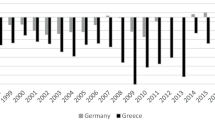Abstract
This paper analyses the efficient market hypothesis. It proposes a new method of testing the efficient market hypothesis based on the idea of Shiller (1979). Using a GARCH model, we test whether the excess volatility in the German and US sovereign debt markets is an indication of inefficient markets during different periods. The results indicate that omitting structural breaks may lead to wrong results. We find that although both debts were efficient during some periods and inefficient during other periods of time. Taking all periods together the financial markets appear to be inefficient. Hence, the general outcome was that both financial markets are not efficient markets.
Similar content being viewed by others
References
Abreu D, Brunnermeier MK (2003) Bubbles and crashes. Econometrica 71(1):173–204
Bai J, Perron P (1998) Estimating and testing linear models with multiple structural changes. Econometrica 66(1):47–78
Ball R (2009) The global financial crisis and the efficient market hypothesis: what have WE learnt? J Appl Corp Finance 21(4):8–16
Barberis N, Thaler RH (2003) A survey of behavioral finance. In: Constantinides G, Harris M, Stulz R (eds) Handbook of the economics of finance. North-Holland, Amsterdam, pp 1051–1121
Blanchard OJ, Watson MW (1982) ‘Bubbles, Rational Expectations and Financial Markets’, National Bureau of Economic Research, Working Paper No. 945
Bollerslev T, Hodrick RJ (1992) ‘Financial Market Efficiency Tests’, National Bureau of Economic Research, Working Paper No. 4108
Daniel K, Hirshleifer D, Subrahmanyam A (1998) Investor psychology and security market under- and overreactions. J Financ 53(6):1839–1885
De Bondt W (2000) The psychology of underreaction and overreaction in world equity markets. In: Keim DB, Ziemba WT (eds) Security market imperfections in worldwide equity markets. Cambridge University Press, Cambridge, pp 65–69
De Bondt W, Muradoglu G, Shefrin H, Staikouras SK (2008) Behavioral finance: Quo Vadis? J Appl Finance 19(2):7–21
Fama EF (1965) Random walks in stock market prices. Financial Anal J 21(5):55–59
Fama EF (1970) Efficient capital markets: a review of theory and empirical work. J Financ 25(2):383–417
Hong H, Stein JC (1999) A unified theory of underreaction momentum trading and overreaction in asset markets. J Financ 54(6):2143–2184
Hughes Hallett A, Richter C (2002) Are capital markets efficient? Evidence from the term structure of interest rates in Europe. Econ Soc Rev 33(3):333–356
Hughes Hallett A, Richter C (2004) Spectral analysis as a tool for financial policy: an analysis of the short end of the British term structure. Comput Econ 23:271–288
Kourtidis D, Sevic Z, Chatzoglou P (2011) Investors’ trading activity: a behavioural perspective and empirical results. J Socio-Econ 4(5):548–557
LeRoy SF, Porter RD (1981) The present-value relation: tests based on implied variance bounds. Econometrica 49(3):555–574
Malkiel BG (1962) Expectations, bond prices, and the term structure of interest rates. Q J Econ 76(2):197–218
Malkiel BG (2003) The efficient market hypothesis and its critics. J Econ Perspect 17(1):59–82
Malkiel BG (2005) Reflections on the efficient market hypothesis: 30 years later. Financial Rev 40(1):1–9
Musunuru N (2014) Modeling price volatility linkages between corn and wheat: a multivariate GARCH estimation. Int Adv Econ Res 20(3):269–280
Philips RA (1997) Stakeholder theory and a principle of fairness. Bus Ethics Q 7(1):51–66
Shiller RJ (1979) The volatility of long-term interest rates and expectations models of the term structure. J Polit Econ 87(6):1190–1219
Shiller RJ (1981a) The use of volatility measures in assessing market efficiency. J Financ 36(2):291–304
Shiller RJ (1981b) Do stock prices move too much to be justified by subsequent changes in dividends? Am Econ Rev 71(3):421–436
Shiller RJ (1992) Market volatility. MIT Press, Cambridge
Shiller RJ (2003) From efficient markets theory to behavioural finance. J Econ Perspect 17(1):83–104
Timmermann A, Granger CWJ (2004) Efficient market hypothesis and forecasting. Int J Forecast 20(1):15–27
Author information
Authors and Affiliations
Corresponding author
Rights and permissions
About this article
Cite this article
Fakhry, B., Richter, C. Is the sovereign debt market efficient? Evidence from the US and German sovereign debt markets. Int Econ Econ Policy 12, 339–357 (2015). https://doi.org/10.1007/s10368-014-0304-9
Published:
Issue Date:
DOI: https://doi.org/10.1007/s10368-014-0304-9
Keywords
- Shiller volatility test
- Efficient market hypothesis
- Neoclassical economics
- Bounded rationality
- Applied econometrics




